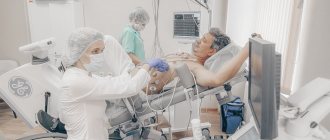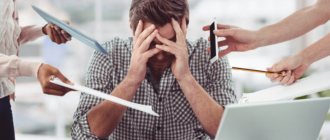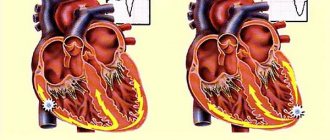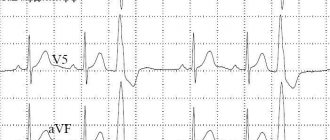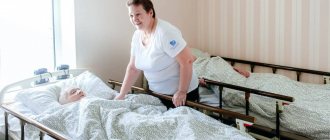August 24, 2011
Why does stress cause cardiovascular diseases? Modern man does not use the stress response as intended.
Nowadays it is customary to talk a lot about the dangers of stress for humans. However, stress is a natural physiological reaction
human body. And it should not be regarded solely as a pathological process. Professor Sergei Boytsov, chief specialist in preventive medicine at the Russian Ministry of Health and Social Development, talks about the effect of stress on the cardiovascular system.
Harmful or not?
It cannot be said that stress is definitely harmful. After all, this is a special function that allows the body to survive. And when we are talking about a young and healthy person, the body’s reaction to stress irritation is almost painless. Stress is easily tolerated if you manage to “discharge”
.
Stress itself is the release of a large number of various biologically active substances that accelerate all processes in the body. Nature has provided this process so that a person in a critical situation can mobilize and perform effective physical actions: run, fight, lift weights. In modern humans, all stress hormones are released into the body in the same way as in distant ancestors, but are often not used for their intended purpose - for physical activity
. “A good example of the positive impact of stress on a modern person is the work of an actor,” says Boytsov. “Every appearance on stage is a stressful situation for them. Which is discharged through the release of emotions during the game.”
Medical Internet conferences
An important pathogenetic link in the development of many diseases is the stress response caused by various environmental factors (Bespalova T.A., 1997; Vinogradov V.V., 2007). The nature and degree of developing changes vary depending on the nature of the stress agent, its strength and duration of impact (Byshevsky A.Sh., Kozhevnikov V.N., 1986). It is known that stress significantly changes the coagulation ability of the blood. However, in the literature there is no connection between the degree of change in the coagulation potential of the blood and the quantitative and qualitative parameters of the stress agent. This fact determined the path of our research.
The purpose of the work was to study changes in the coagulation potential of the blood under the influence of various stress agents. We studied the state of the hemocoagulation system in three stress models: short-term (5-minute) immobilization, 2-minute combined (immobilization-sound) and physical hyperthermia.
The experiments were carried out on 80 outbred white male rats weighing 180-220 g. To reproduce the stress response in the experiment, the following models were used:
1) rigid immobilization of rats in the supine position for 5 minutes;
2) the effect of an acoustic stimulus against the background of rigid immobilization for 2 minutes. Rats immobilized in the supine position were placed in a plexiglass chamber with a volume of 2000 cm3 and exposed to sound of 120 dB, frequency 150-500 Hz. The sound source (electric bell) was mounted on the chamber wall so as to prevent its vibration.
3) physical hyperthermia was achieved by placing rats in a thermostat for 30 minutes at a temperature of 40°C.
The control for all groups were intact animals.
The animals' blood was stabilized with a 3.8% sodium citrate solution in a 9:1 ratio in a plastic tube. Platelet-rich plasma was obtained by centrifuging citrated blood at 1000 rpm for 10 minutes.
In the first series of experiments, the stress response was caused by rigid immobilization of the animals in a supine position for 5 minutes. Stress exposure was accompanied by changes in biochemical parameters of hemocoagulation. The time of recalcification in siliconized and non-siliconized tubes, the level of fibrinogen in the blood and thrombin time did not change after exposure to a stress agent, which indicates the absence of activation of plasma coagulation processes, as well as the stable state of the membrane of blood cells, including platelets. In parallel, there is an increase in the platelet activity index (p<0.001), which is associated with an increase in the functional activity of platelets. Changes in the anticoagulant link are expressed in an increase in the activity of antithrombin III (p <0.05), while the content of heparin in the blood plasma did not differ from the control. The total fibrinolytic activity does not differ from the control; there is only a tendency to increase the activity of plasminogen activators (p>0.05). Paracoagulation products were not detected in the plasma of experimental animals under this stress model.
Consequently, data from laboratory studies of hemocoagulation indicate some stimulation of the functional activity of platelets under 5-minute immobilization stress. Along with this, the activation of the anticoagulant link increases and there is a tendency to increase fibirinolytic activity.
Next, a series of experiments were conducted on another more severe stress model. An intense sound stimulus (120 dB, 150-500 Hz) was used as a stress factor, along with rigid immobilization. The short duration (2 minutes) of the stressor action makes it possible to identify changes in hemocoagulation that occur in the early stages of the formation of a stress response.
The combined effect of sound and immobilization for 2 minutes causes a more pronounced effect than in the previous stress model, an increase in plasma coagulation processes. Thus, the recalcification time is shortened in siliconized (p<0.001) and non-siliconized tubes (p<0.001), which indicates an increase in coagulation processes through the internal activation mechanism. A significant increase in the platelet activity index (ITA, p<0.01) indicates an increase in the coagulation potential of platelets under the conditions of this stress model. Noteworthy is the shortening of thrombin time (p<0.02), with a simultaneous increase in fibrinogen content (p<0.01) in plasma. Paracoagulation products are not detected in the blood plasma of experimental animals after short-term immobilization-sound stress. Changes are also observed in the anticoagulant link: the content of plasma heparin decreases (p<0.05) with a constant amount of antithrombin-III (p<0.2). Combined 2-minute stress is accompanied by a significant increase in total fibrinolytic activity (p <0.05).
Consequently, the studies conducted indicate an increase in hemocoagulation processes under short-term combined stress. Activation of the blood coagulation process through the internal activation mechanism occurs due to an increase in the rate of fibrin formation, as well as an increase in the functional activity of platelets under this stress model. In this case, fibrinolytic activity is activated, however, there is a slight decrease in anticoagulant activity.
Next, we used 30 minutes of physical hyperthermia as a model of stress. The duration of action of the stressor agent made it possible to study not only the dependence of the coagulation potential of the blood on the duration of action of the stressor agent, but also to evaluate the adaptive mechanisms of coagulation that arise during this process. Activation of intravascular coagulation by an internal mechanism during 30-minute physical hyperthermia is evidenced by a shortening of the recalcification time in siliconized (p < 0.001) and non-siliconized tubes (p < 0.001), which indicates an increase in activation of coagulation processes. A significant increase in the index of platelet activity (ITA, p<0.001) and the index of contact activation (IDCA, p<0.001) indicates an increase in the coagulation potential of platelets under the conditions of this stress model. Noteworthy is the increase in fibrinogen content (p<0.01) in plasma. Activation of the anticoagulant link is expressed in a decrease in the content of plasma antithrombin-III (p<0.02), with a constant amount of heparin (p<0.05). There is a pronounced increase in total fibrinolytic activity (p<0.01), in parallel with this there is an increase in plasmin activity (p<0.001) and the activity of plasminogen activators (p<0.001). Along with this, the content of plasminogen decreases (p <0.001).
The results obtained indicate activation of the blood coagulation process by an internal mechanism, activation of intravascular coagulation, and changes in the membrane of the formed elements. In addition, an increase in the activity of anticoagulants and fibrinolysis was noted.
Thus, changes in hemocoagulation detected in the three experimental models of stress used in our studies consist of an increase in hemocoagulation processes, although more pronounced changes are observed during physical hyperthermia. This indicates a clear dependence of the severity of stress changes in hemocoagulation on the strength of the stress agent. The unidirectionality of the changes observed in different models is, to a certain extent, evidence of the “stressor” nature of these changes, since one of the most important signs of stress (according to Selye) is the nonspecificity of the detected changes and their relative independence from the nature and modality of the stressor. As a result of the studies, it was established that short-term stress has a significant effect on hemocoagulation, which is expressed in the activation of the coagulation potential of the blood. In our experiments, an increase in fibrinolytic activity was noted. At the same time, with a 5-minute stress, there is an increase in plasma anticoagulant activity, while it slightly decreases with a 2-minute combined stress. Noteworthy is the fact that a typical reaction to short-term stress is an increase in the functional activity of platelets, as evidenced by an increase in the platelet activity index. Physical hyperthermia caused the most significant changes, which consisted of activation of intravascular coagulation, increased platelet activity, activation of anticoagulants and fibrinolysis.
Stress in modern society
A clear illustration of the effect of stress on the development of cardiovascular diseases is mortality statistics for the 1990s in Russia. The first peak in the increase in mortality
occurred in 1991-92, and the second in 1998. These peaks fit very well with the chronology of the political and economic development of the country itself. The collapse of the USSR in the early 1990s resulted in a sharp increase in emotional and mental stress and, as a result, an increase in mortality. A similar situation was observed in 1998. “Of course, it is impossible to say that all deaths during this period were the result of cardiovascular diseases,” Boytsov notes, “but their percentage was very high.”
Meditation and psychotherapy, their impact on health
Meditation is a great way to cope with depression and stress without medication.
The effect of meditation on the body is:
- Improving brain function. It has been scientifically proven that a course of meditation helps restore brain cells;
- Reducing the risk of developing heart disease;
- Eliminate feelings of anxiety;
- Developing mental resistance to stress;
- Increasing immunity and strengthening the body's defenses.
Scientists from Washington conducted an interesting study. 15 colleagues from one enterprise voluntarily took part in it. Before the rehabilitation course, each of the volunteers underwent a stress resistance test. It turned out that 14 out of 15 workers live in constant stress and cannot effectively cope with nerve-wracking situations.
The workers completed an eight-week meditation course under the supervision of a specialist - and a repeat test showed that the workers became much calmer and learned to control their emotions. Psychotherapy also shows good results - it helps solve problems and combat anxiety.
How to deal with the effects of stress?
Learn the correct response to a stressful situation so that the body's reaction to stress is minimal. Some people are quite calm due to their temperament. But very emotional people who react sharply to the slightest shock in life should visit a psychologist
or psychotherapist.
The specialist will teach you how to manage your reaction to life’s collisions. In addition, get out of stress correctly if it does occur. If it is possible to perform physical exercises
immediately after a stressful situation, the body mobilized to fight will receive the necessary release. It’s hard to imagine an office worker who, after being scolded by management, left the office and went for a run. But there is always the possibility of some kind of physical activity - run up the stairs, do a few push-ups or pull-ups. After this, the body's reaction to stress will be much easier.
The impact of stress on human health
Scientists have proven that the body of people who are constantly exposed to stress wears out 40% faster than those of those people who live in peace. Frequent stressful situations cause the following symptoms:
- Redness of the skin, various rashes;
- Feeling tired and exhausted even after a full sleep;
- Loss or gain of body weight;
- Constant feeling of anxiety;
- Tremor (shaking) of the limbs;
- Stool disorder.
If you do nothing, there is a high chance of developing the following pathological processes:
- Panic attacks;
- Depression;
- Heart failure;
- Stomach ulcer;
- Hypertension;
- Anorexia;
- Stress can also cause a decrease in sex drive in both women and men.
Test yourself
If you are already 35-40 years old
, determine how serious your factors for developing cardiovascular diseases are. To do this, check your blood pressure and cholesterol levels and determine the presence of bad habits. If the risk level is high, go for an in-depth examination from specialists. It may be time for you to start taking special medications that protect the cardiovascular system. Among them, there are also those that can reduce the release of stress hormones and the emotional reaction to a traumatic situation.
Why do we experience stress?
Emotional anxiety is a complexly organized state. When we experience stress, our body's internal chemistry changes. First of all, the level of cortisol increases, this is the main stress hormone along with adrenaline and norepinephrine. As a result, blood sugar levels rise and more glucose enters the brain.
In general, this is not bad - this chain helps the body in the so-called “fight or flight” reaction, which has deep evolutionary significance and protects us to this day. In prehistoric times, our ancestors needed an additional incentive that told them whether to fight the enemy or retreat. In case of danger, muscle strength, reaction speed, endurance and even pain threshold increased for a short time. These days, these biochemical reactions come into play to help us make quick decisions when we're under pressure.
Than the heart will calm down
Photo: RIA Novosti/Evgeniy Biyatov
However, our body prepares for battle not only at the moment of a serious threat. The same processes are triggered when we are late for work or argue with family members. Some people have also faced long-term psychological stress during the pandemic. In such cases, the reaction to increased anxiety turns out to be more harmful than beneficial.
A breath of despair: how air spoils men's health
Scientists have found that air pollution negatively affects the brain and reduces reproductive functions.
The most important
Stress is a natural and necessary process for the body, which in modern man proceeds according to the wrong pattern.
Therefore, stress leads to cardiovascular diseases. The best way to combat the effects of stress is physical activity and timely consultation with a doctor. Tags:
- Heart and blood vessels
- Older age
- Stress
1 comment • To leave a comment you must be an authorized user
- Foxic-7 I suffered greatly from constant stress at work... painstaking and monotonous work with documentation, requiring a lot of attention... harmful bosses... now Rebion's aerovitamins save me.. Spray the room with a spray and enjoy the pleasant aroma! No stress, no fatigue... and here's to working with new strength and a surge of energy!
How to calm yourself on the weekend
Time for change: how to improve your health at home
Doctors advise starting with giving up alcohol and junk food.
The appearance of anxiety during a long weekend is a very real risk, said Andrei Tyazhelnikov, chief freelance specialist in primary health care for adults at the Moscow Department of Health.
“In addition to limiting your social circle and a general alarming information background, the development of this condition is facilitated by waning days, lack of sun, and colder weather,” the expert explained.
In order to avoid unpleasant thoughts, doctors consider it necessary to stock up on good films, books for which there was no time before, and also devote time to hobbies. A great option would be a walk or an excursion - physical activity helps produce beneficial hormones, including dopamine, which lifts your mood.
However, not all ways to put the nervous system in order are equally good, doctors say.
Than the heart will calm down
Photo: RIA Novosti/Nikolai Khizhnyak
“It is dangerous to “relax” and “relax” with alcohol. Firstly, alcohol will contribute to weight gain, and secondly, it will put additional stress on the heart and liver. Instead of rest, the body will work to remove toxins,” the specialist added.
Psychologist at the Doctor Nearby service Marina Reshetnikova also noted the need to limit stress-creating situations during the November weekend. To combat anxiety, she, in particular, recommends dancing. “Express your emotions through dance. Listen to your favorite musical composition and try to come up with your own dance,” Reshetnikova advised.
A dream is just a dream: how residents of big cities can solve sleep problems
At the same time, chronic lack of sleep has mainly social causes.
Urine tests:
General urine analysis
- On the eve of the test, it is recommended not to eat vegetables and fruits that can change the color of urine (beets, carrots, etc.), and not to take diuretics.
- Before collecting urine, it is necessary to perform a thorough hygienic toilet of the genitals.
- Women are not recommended to take a urine test during menstruation.
Collect your morning urine in a container. To properly conduct the study, during the first morning urination, release a small amount of urine (the first 1 - 2 seconds) into the toilet, and then, without interrupting urination, place a urine collection container into which to collect approximately 50-100 ml of urine. Close the container tightly with the screw cap.
A specialized plastic container is the optimal means of collecting and transporting urine for laboratory research. Ask at pharmacies. The container is a wide-neck graduated translucent glass with a capacity of 125 ml with a hermetically screw-on lid. The container is sterile, does not require pre-treatment and is completely ready for use.
Nechiporenko test
To analyze urine using the Nechiporenko method, the morning portion is collected in the middle of urination (“middle portion”). 15-25 ml is enough.
24-hour urine collection
For laboratory studies, in the morning before collecting urine, it is necessary to toilet the external genitalia.
The first morning urine sample is not collected, but the time of urination is noted. Subsequently, all urine excreted in 24 hours from the marked time of the first urination to the same hour the next day is collected.
The collection of daily urine is optimally carried out in a specialized graduated plastic container of 2.7 liters, which has a wide neck and a textured handle. The container is safe and easy to handle.
You should urinate directly into the container and screw the lid tightly after each urination. Urine should be stored in a closed container in the refrigerator on the bottom shelf, avoiding freezing.
At the end of the collection (the last urination is performed at the same time, which is marked as the time of the first urination, but one day later), the urine can be submitted to the laboratory: the daily volume of urine in a closed container is shaken, after which it is poured into a small container for clinical urine analysis of 125 ml 100 ml portion. You don't need to bring all your urine. At the medical center, report the daily amount of urine.
Collection of daily urine according to Zimnitsky
Urine is collected per day (8 servings in 8 containers, every 3 hours). The first portion of urine in the morning is removed. All subsequent portions of urine excreted during the day, night and the morning portion of the next day are collected in different containers (50 ml) purchased at the pharmacy, each with the time of collection signed.
After collecting urine, accurately measure the contents of the container, be sure to mix it and immediately pour it into a container purchased at the pharmacy. Bring the container to the medical center for examination. You don't need to bring all your urine. At the medical center, report the daily amount of urine.
Urine for sugar
From the daily amount of urine, 50-100 ml of urine or 3 portions of urine collected per day with intervals of 8 hours are delivered to the laboratory:
1 serving - from 8 to 16 hours
2 servings - from 16 to 24 hours
3 servings - from 24 to 8 am (as directed by a doctor).
Urine for PCR studies (tuberculosis, CMV, STIs)
Before collecting urine, it is necessary to toilet the external genitalia. Urine is collected in the morning on an empty stomach after sleep or no earlier than 2-3 hours after the last urination into a sterile plastic container. The minimum volume of urine required for analysis is 20 ml.
Urine for bacteriological research
The urine sample is collected only in a sterile container.
Urine must be collected before starting antibacterial treatment or 3 days after therapy. If the patient is taking antibacterial drugs, then it is necessary to decide on their temporary withdrawal.
After thoroughly toileting the external genitalia, flush the first portion of urine into the toilet, collect the middle portion of 3-5 ml in a sterile hermetically sealed container. Deliver the urine to the laboratory within 1-2 hours; if this is not possible, then the urine sample can be stored in the refrigerator for no more than a day. When transporting the sample, care must be taken to ensure that the stopper does not get wet.
How to learn to control your psycho-emotional state?
How to maintain health and increase stress resistance?
- Don't take on several things at once. Complete every task you start without being distracted by extraneous factors. If your job does not allow you to do only one thing, make a schedule for the priority of tasks and, in the time allocated for a task, do only it.
- If you are nervous about a situation, ask yourself if there is something you can do. If not, then you need to come to terms with the fact that this situation and its result are beyond your control and try to distract yourself with something else. If you can, no need to worry, just do it.
- Try to develop independent self-esteem. Of course, listening to a negative assessment and scolding is unpleasant - but, if you think about it, this assessment has nothing to do with you. This is just the opinion of another person, which can be taken into account if the person is important to you, but should not be taken as an objective reality. Evaluate yourself.
- Set realistic goals for yourself. Not the easiest, but achievable. When determining the deadline for completing a task, reserve 15-20% of the time for force majeure situations and the human factor, then delays will not unsettle you.
- Light physical activity helps stabilize the psycho-emotional state - nothing calms you down like a light jog or swimming.
- Go to bed no later than 11 pm, try to sleep at least 8 hours.
- Organize your workplace in such a way that it is pleasant to be there and easy to find everything you need.
- Eat the right foods. For the stability of your psycho-emotional state, it is very important to eat a balanced diet. B vitamins are especially important.
- At least once a week, do something that makes you happy. Meet with friends, dance, eat delicious food, play computer or board games.
If nothing helps, and you feel that it is difficult for you to cope with stress on your own, contact a specialist; you may have depression. In this case, you need qualified treatment.

